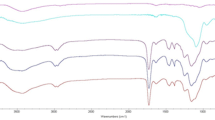Abstract
Molecular imprinting technology is a specialized technique used to create selective recognition sites within synthetic polymers. It has been employed in the removal of environmental contaminants like pesticides. In this research, a magnetic molecularly imprinted polymer (MMIP) centered on chlorpyrifos as the template molecule was successfully synthesized. Ethyleneglycol dimethacrylate (EGDMA) was the crosslinker, functional monomer used was methacrylic acid (MAA) and initiator was AIBN (2,2′-azobis-isobutyronitrile). The MMIP was successfully characterized using Fourier-transform infra-red (FTIR), scanning electron microscope (SEM), energy dispersive X-ray (EDX), and X-ray diffraction (XRD). The MMIP recorded a high adsorption capacity and selectivity for chlorpyrifos. The MMIP was then used as a dispersive solid phase extraction (D-SPE) adsorbent for isolating and extracting chlorpyrifos from water samples. A gas chromatograph coupled with an electron capture detector (GC-ECD) was used to quantify the extracts. When compared to C-18 solid phase extraction (SPE), the MMIP recorded spiked chlorpyrifos recoveries between 82 and 104% while that for C-18 SPE ranged between 64 and 81%. The limits of quantification (LOQ) and detection (LOD) were 4.91 and 1.62 mg/L respectively.






Similar content being viewed by others
REFERENCES
S. Farooq, J. Nie, Y. Cheng, Z. Yan, J. Li, S. A. S Bacha, A. Mushtag, and H. Zhang, Analyst 143, 3971 (2018).
S. Boulanouar, S. Mezzache, A. Combès, and V. Pichon, Talanta 176, 465 (2018).
G. T. Bakırcı, D. B. Y. Acay, F. Bakırcı and S. Ötleş, Food Chem. 160, 379 (2014).
A. Speltini, A. Scalabrini, F. Maraschi, M. Sturini, and A. Profumo, Anal. Chim. Acta 974, 1 (2017).
A. Azizi and C. S. Bottaro, J. Chromatogr. A 1614, 460603 (2020).
J. **n, X. Qiao, Y. Ma, and Z. Xu, J. Sep. Sci. 35, 3501 (2012).
M. Simões, N. Martins, M. J. Cabrita, A. J. Burke, and R. Garcia, J. Polym. Res. 21, 14 (2014).
A. Sarafraz-yazdi and N. Razavi, Trends Anal. Chem. 73, 81 (2015).
K. A. Sarpong, W. Xu, W. Huang, and W. Yang, Am. J. Anal. Chem. 10, 202 (2019).
V. Pichon, N. Delaunay, and A. Combes, Anal. Chem. 92, 16 (2020).
R. Garcia, E. P. Carreiro, J. C. Lima, M. G. da Silva, M. C. Freitas, and M. J. Cabrita, Food Chem. 254, 309 (2018).
N. Cengiz, G. Guclu, H. Kelebek, E. Capanoglu, and S. Selli, ACS Omega 7, 15258 (2021)
Y. Zhang and X. Yao, Polym. Sci., Ser. B 56, 538 (2014).
P. L. Hariani, M. Faizal, R. Ridwan, M. Marsi, and D. Setiabudidaya, Int. J. Environ. Sci. Dev. 4, 336 (2013).
D. **ao, P, Dramou, N. **ong, H. He, H. Li, D. Yuan, and H. J. Dai, J. Chromatogr. A 1274, 44 (2013).
S. S. Miao, M. S. Wu, H. G. Zuo, C. Jiang, S. F. **, Y. C. Lu, and H. Yang, J. Agric. Food Chem. 63, 3634 (2015).
W. A. Wan Ibrahim, H. R. Nodeh, H. Y. Aboul-Enein, and M. M. Sanagi, Crit. Rev. Anal. Chem. 45, 270 (2015).
J. Li, Q. Zhou, Y. Yuan, and Y. Wu, R. Soc. Open Sci. 4, 8 (2017).
S. Panda, I. Aggarwal, H. Kumar, L. Prasad, A. Kumar, A. Sharma, D. Vo, D. Van Thuan, and V. Mishra, Environ. Chem. Lett. 19, 1 (2021).
H. G. Zuo, J. X. Zhu, C. R. Zhan, L. Shi, M. **ng, P. Guo, Y. Ding, and H. Yang, Environ. Monit. Assess. 187, 7 (2015).
M. M. Sanagi, S. Salleh, W. A. Wan Ibrahim, and A. Abu Naim, Malaysian J. Fundam. Appl. Sci. 6, 27 (2014).
M. Peyrovi, M. Hadjmohammadi, and I. Saeidi, Biomed. Chromatogr. 33, e4404, (2019).
R. Karimian, F. Piri, and Z. Hosseini, J. Appl. Biotechnol. Rep. 4, 533 (2017).
H. El Ghandoor, H. M. Zidan, M.H. Khalil, and M. I. M. Ismailand, Int. J. Electrochem. Sci. 76, 5734 (2012).
H. Hashemi-Moghaddam and D. J. Jedi, Int. J. Environ. Anal. Chem. 95, 33(2015).
M. Chen, X. Ma and J. Sheng, IOP Conf. Ser: Mater. Sci. Eng. 9269, 012061 (2017).
F. Ning, H. Peng, J. Li, L. Chen, and H. **ong, J. Agric. Food Chem. 62, 7436 (2014).
H. R. Geng, S. S. Miao, S. F. **, and H. Yang, Anal. Bioanal. Chem. 407, 8803 (2015).
H. G. Zuo, H. Yang, J. X. Zhu, and Y. Ding, Anal. Methods 9, 6009 (2017).
A. O. Gryshchenko and C. S. Bottaro, Int. J. Mol. Sci. 15, 1338 (2015).
R. J. Ansell, “Molecularly Imprinted Polymers in Biotechnology,” in Advances in Biochemical Engineering/Biotechnology, Ed. by B. Mattiasson and L. Ye (Springer Int., Switzerland, 2015).
W. Winingsih, S. Ibrahim, and S. Damayanti, Rasayan J. Chem. 15, 1296 (2022).
X. L. Zhu, J. Yang, Q. D. Su, J. B. Cai, and Y. Gao, J. Chromatogr. A 1092, 161 (2005).
ACKNOWLEDGMENTS
The authors wish to thank the staff and technicians at the Regional Water and Environmental Sanitation Centre Kumasi (RWESCK) for the analysis.
Funding
This work was supported by ongoing institutional funding. No additional grants to carry out or direct this particular research were obtained.
Author information
Authors and Affiliations
Contributions
Flora Amarh: Conceptualization, Writing-Original draft preparation. Eric Selorm Agorku: Methodology. Ray Voegboelo: Supervision. Ahmed Kangmennaa: Writing review and editing.
Corresponding author
Ethics declarations
The authors of this work declare that they have no conflicts of interest.
Additional information
Publisher’s Note.
Pleiades Publishing remains neutral with regard to jurisdictional claims in published maps and institutional affiliations.
Rights and permissions
About this article
Cite this article
Flora Amerley Amarh, Kangmennaa, A., Agorku, E.S. et al. Synthesis and Characterization of Magnetic Molecularly Imprinted Polymers for the Adsorption of Chlorpyrifos from Aqueous Media. Polym. Sci. Ser. B (2024). https://doi.org/10.1134/S1560090424600360
Received:
Revised:
Accepted:
Published:
DOI: https://doi.org/10.1134/S1560090424600360




